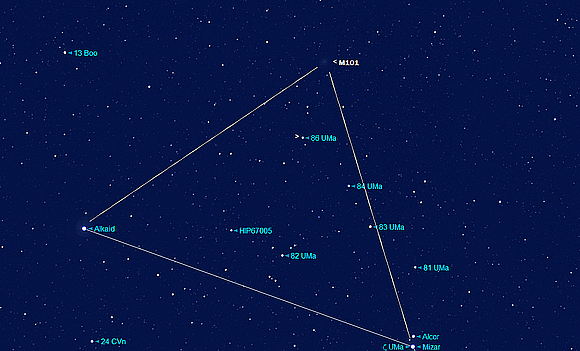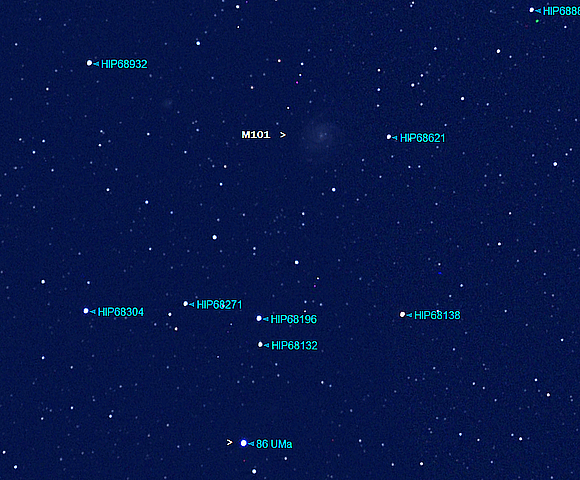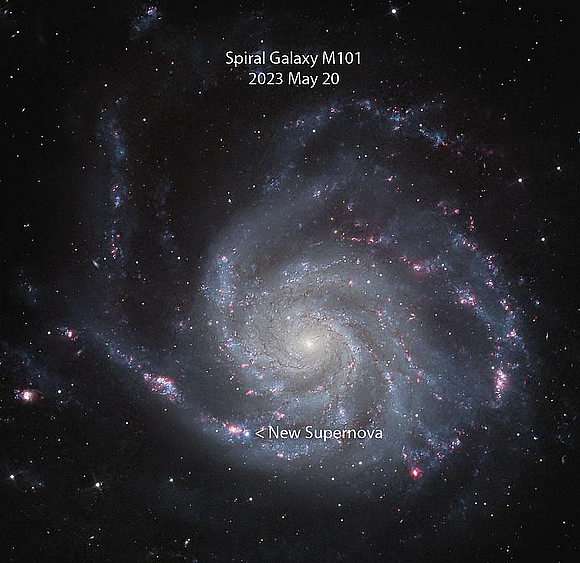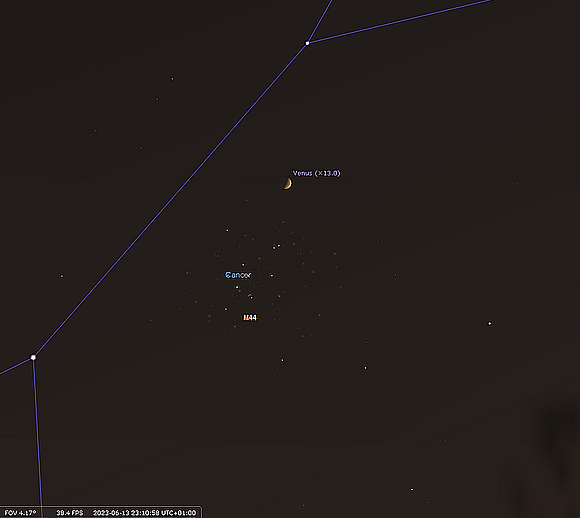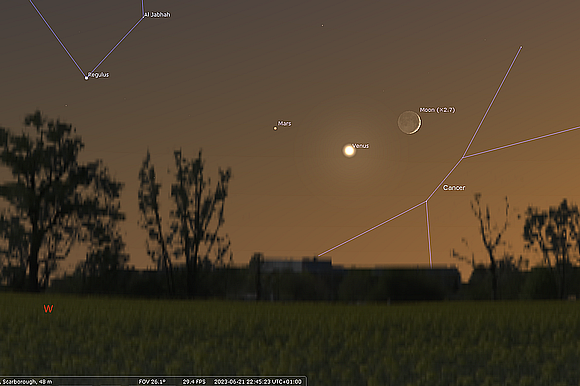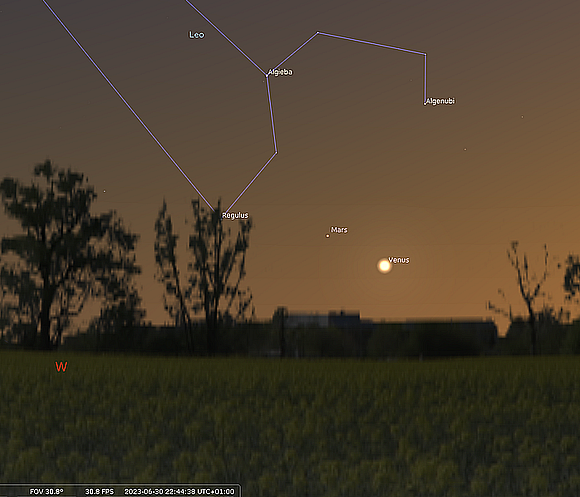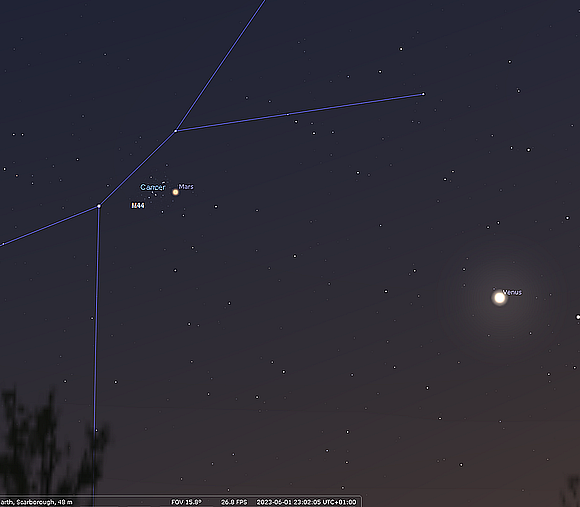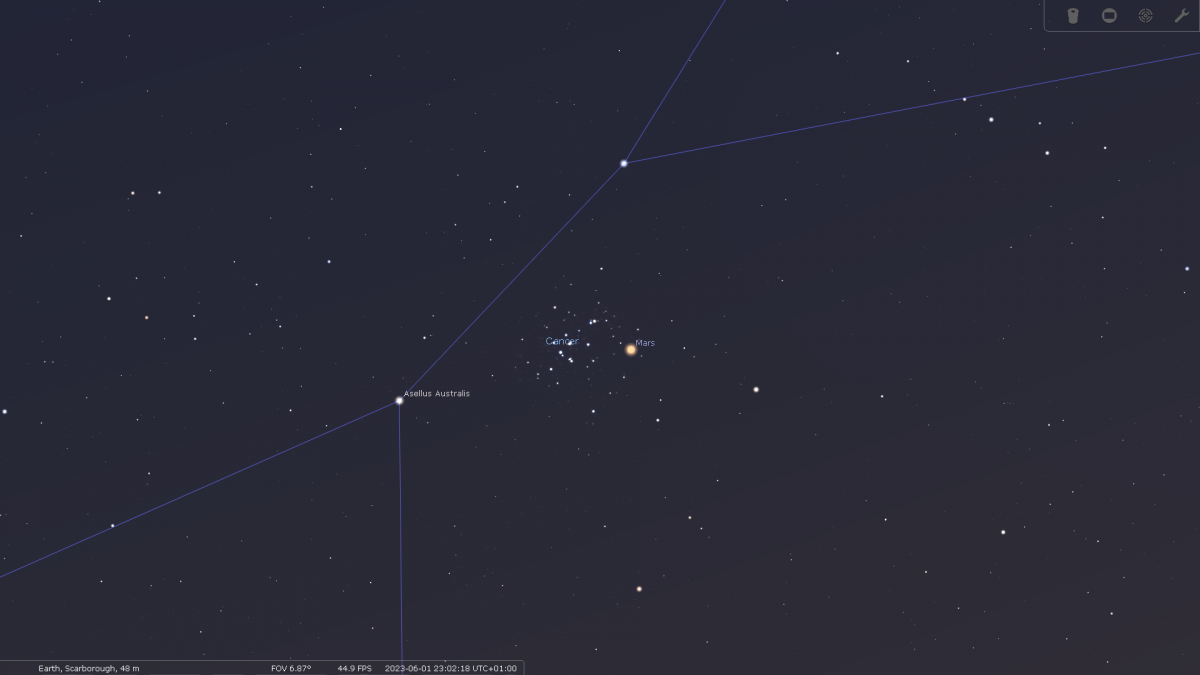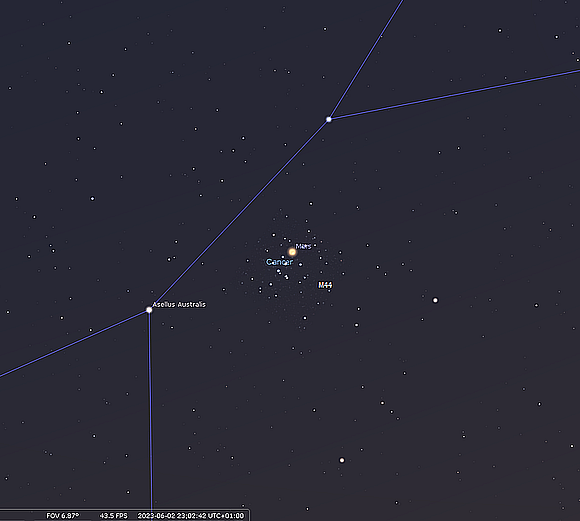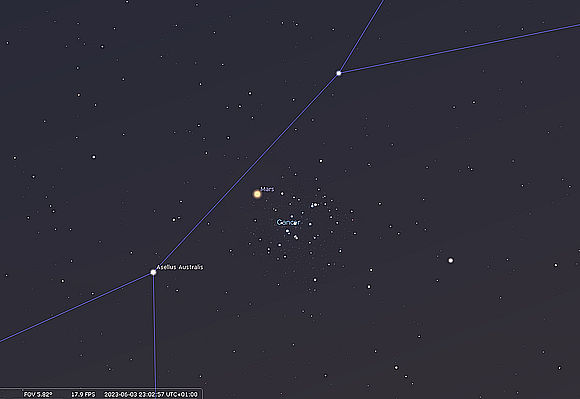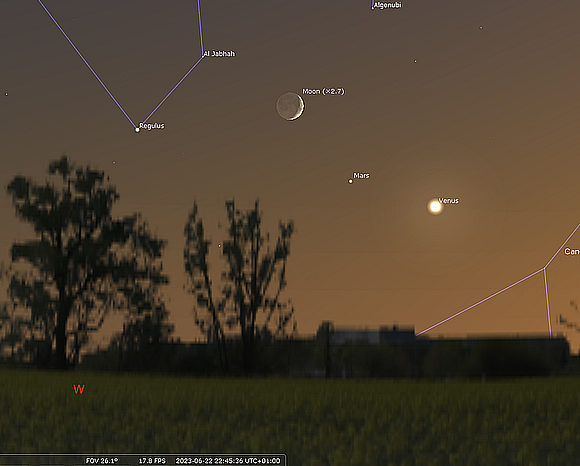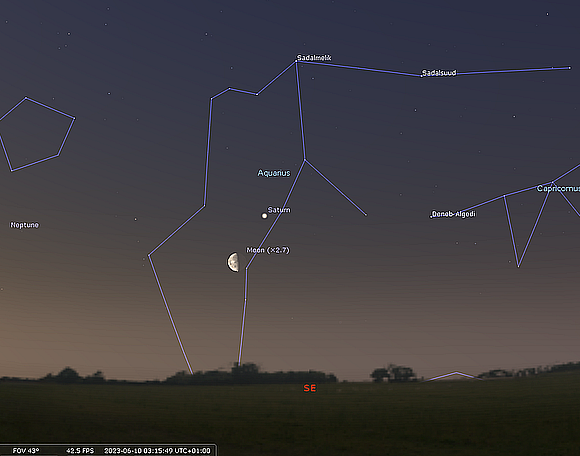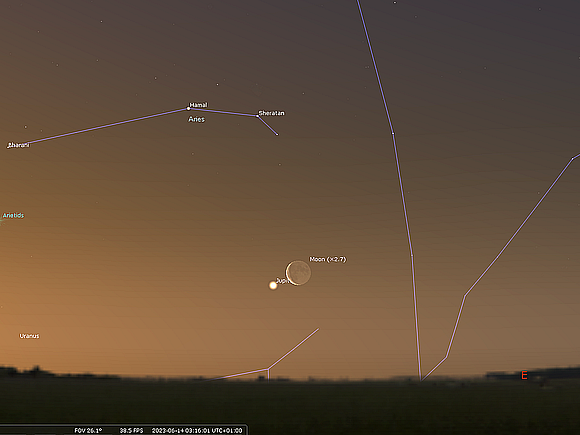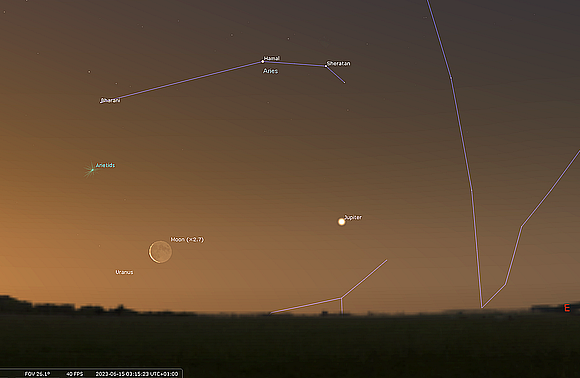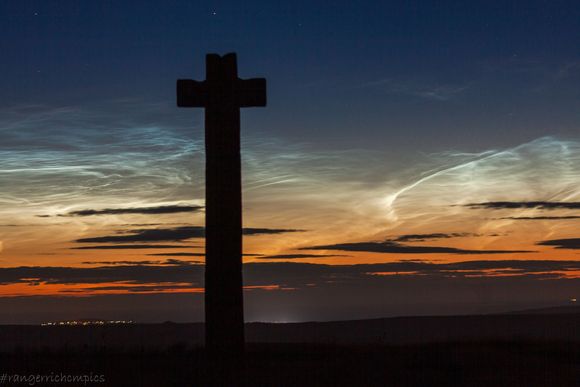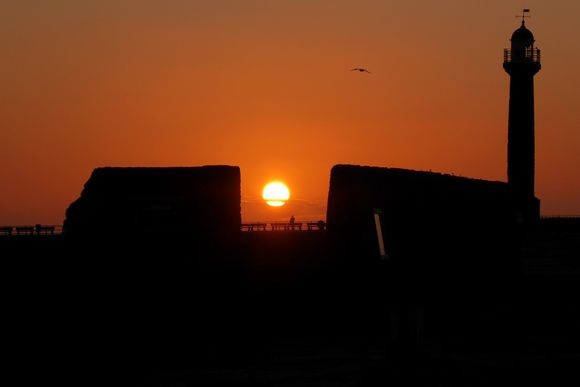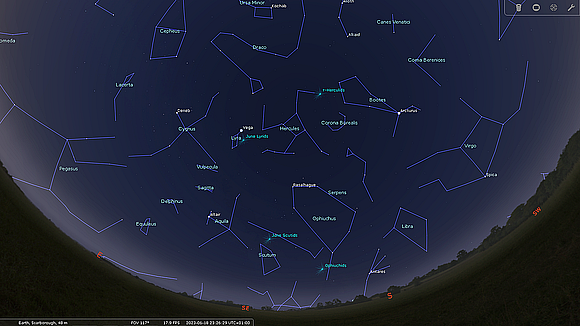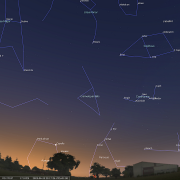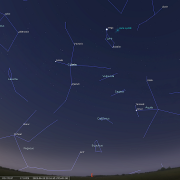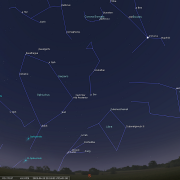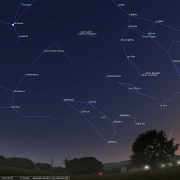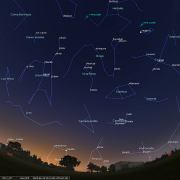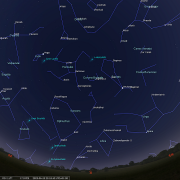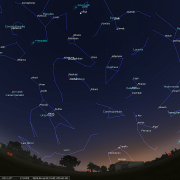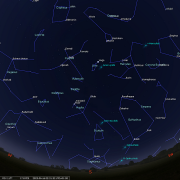In this month's Sky Notes:
- Supernova in M101 galaxy.
- Planetary Skylights.
- June Meteors and NCC.
- Summer Solstice.
- June Night Sky.
- June 2023 Sky Charts.
Supernova visible in M101
We have a supernova! Alas though, not in our galaxy, one that is far, far, away. Well, 21 million light years is far away, but it is the closest supernova for a decade. Discovered on May 19th by Koichi Itagaki, supernova 2023ixf lies in one of the major spiral arms of M101, a face on galaxy in Ursa Major. The galaxy is also known as the 'Pinwheel' galaxy - one of two galaxies north of the celestial equator called 'Pinwheel', the other - M33, being in Triangulum, a member of our 'local group'. Observers may recall SN 2011FE, the last bright supernova also seen in M101 discovered in August 2011. The Type 1a blast reached a peak magnitude of 9.9 and was quite an easy spot in 60mm telescopes and above. The question is, will 2023ixf surpass it? Initially a 14.9 magnitude object, as of writing (May 29th) this has climbed to mag +10.9 and should be visible in 4.5-inch (114mm) instruments.
M101 can be a little tricky to locate, but if you use the stars Alkaid and Mizar in the ‘arm’ of the Plough as triangulation points and M101 as the third, it should be easy - see charts. It is at least positioned high in the sky from the UK and won't be affected by murk or haze. Being face-on, the light is spread out, so don't expect to observe definitive spiral arms with small apertures. Larger scopes - 10" (250mm) and above will obviously yield more detail, but as the supernova is in effect a point source star, it should be apparent even in smaller instruments. If you want to try to capture the supernova and can locate M101, 30 second exposures are all that is required, preferably a couple of dozen and then stacked together in your favourite stacking app.
Spectra indicate that SN 2023ixf is a Type II supernova — the catastrophic destruction of an aging supergiant star, unable to convert evermore complex elements in the core. The buck stops with Iron, and as nuclear fusion ceases, gravity takes over and the star collapses then rebounds. Such events leave a neutron star or black hole in their wake, dependant on the mass of the star in question. Do then have a go at trying to spot SN 2023ixf, after all it's not every day a star destroys itself!
Planetary Skylights: A Brief Guide to June's Night Sky
Venus remains dominant. Mars raids the Beehive. Saturn and Jupiter visible in the early morning sky.
 Venus continues to dominate the late evening sky, visible well after 23:30hrs before setting in the NW. The 'evening star' is slowly losing the race with twilight glare but will remain on show until mid-July. Observing Venus through a telescope in twilight will help temper its brilliance, allowing easier observation of the phase and any subtle darker shading upon it. As Venus draws closer to Earth (under 74 million Km by the month's end), its brightness continues to grow, from magnitude -4.38 to -4.62 over the course of June, by which time it will exhibit a waning qtr. phase some 33 arc seconds in size.
Venus continues to dominate the late evening sky, visible well after 23:30hrs before setting in the NW. The 'evening star' is slowly losing the race with twilight glare but will remain on show until mid-July. Observing Venus through a telescope in twilight will help temper its brilliance, allowing easier observation of the phase and any subtle darker shading upon it. As Venus draws closer to Earth (under 74 million Km by the month's end), its brightness continues to grow, from magnitude -4.38 to -4.62 over the course of June, by which time it will exhibit a waning qtr. phase some 33 arc seconds in size.
Venus is moving through the faint zodiac constellation of Cancer, passing just to the north of M44 - the Beehive open star cluster from June 12th-14th. You will need to observe shortly after 23:00hrs to view the cluster stars, by which time they will be rather low to the horizon. Any earlier and you may not pick them up in the twilight.
The crescent Moon pays Venus a visit on the 21st, and with Mars only a short distance to the east will make for a picturesque twilight scene. By the end of June, Venus and Mars are closing in the sky, although the separation of the two worlds for this planetary conjunction will be several degrees - so not the closest.
 Mars continues to loiter in the evening twilight sky and is tracking through the faint zodiac constellation of Cancer. At magnitude +1.65, Mars is little brighter than 'average' star status and may be quite hard to spot as it nears the horizon in bright twilight of the WNW.
Mars continues to loiter in the evening twilight sky and is tracking through the faint zodiac constellation of Cancer. At magnitude +1.65, Mars is little brighter than 'average' star status and may be quite hard to spot as it nears the horizon in bright twilight of the WNW.
Through the eyepiece Mars appears very small (under 5 arc seconds) and is little more than a blurry curiosity. The red planet will however be involved in a very fine conjunction as it tracks directly through the heart of the Beehive (M44) open cluster in Cancer on June 1st, 2nd, and 3rd. Observe around 22:45 hrs, and given a good WNW horizon, you will spot Mars smack in the middle of the cluster on the 2nd. By the end of the month Mars is drawing closer to Venus (see Venus). Mars will remain on show until mid-July.
The crescent Moon lies upper left of Mars on June 22nd, viewing around 22:45hrs, with Venus to the lower right.
 Saturn continues to make inroads into the early morning sky, but is awkward for northern hemisphere observers, visible for just a few hours after 01:00hrs before light returns. Many amateur astronomers may therefore not be re-acquainted with the 'ringed wonder' before August, when it finally reaches the late evening sky pre-midnight low to the SE horizon. On June 10th, a waning last quarter Moon passes below Saturn low to the SE horizon, view around 03:00hrs. Saturn currently resides amongst the stars of Aquarius.
Saturn continues to make inroads into the early morning sky, but is awkward for northern hemisphere observers, visible for just a few hours after 01:00hrs before light returns. Many amateur astronomers may therefore not be re-acquainted with the 'ringed wonder' before August, when it finally reaches the late evening sky pre-midnight low to the SE horizon. On June 10th, a waning last quarter Moon passes below Saturn low to the SE horizon, view around 03:00hrs. Saturn currently resides amongst the stars of Aquarius.
 Jupiter is also on show in the dawn sky, low to the ENE horizon around 03:00hrs. It is noticeably brighter than Saturn but is only visible in light skies for the time being as a naked eye/binocular object. Its time will come by mid-August. Should you be up on June 14th around 03:15hrs, look for a slender crescent Moon in close conjunction with Jupiter making for a fine sight. A day later the Moon lies off to the left.
Jupiter is also on show in the dawn sky, low to the ENE horizon around 03:00hrs. It is noticeably brighter than Saturn but is only visible in light skies for the time being as a naked eye/binocular object. Its time will come by mid-August. Should you be up on June 14th around 03:15hrs, look for a slender crescent Moon in close conjunction with Jupiter making for a fine sight. A day later the Moon lies off to the left.
June Meteors and Noctilucent Cloud
Meteor activity is rather sparse in June, with no well-defined meteor showers of note to speak of. The low levels of observed activity are due to several reasons. The short, light nights are certainly one factor, but the low activity that is present chiefly comes from the ecliptic, which from the UK is low to south at this time of year. The minor showers that are apparent produce only a handful of meteors at best.
The Ophiuchids, the radiant of which lies near Theta Ophiuchi - approximately 15 degrees east of Antares, may produce 5 or so per hour with peaks on June 9th and 19th. The Beta Taurids are associated with debris left by Comet P/Encke, but unfortunately the shower occurs during daylight hours over the course of June. Radio detection methods do seem to indicate the shower is one of the strongest 'radio meteor showers' of the year. The Alpha Cygnids yield just a few meteors per hour near the end of June. The radiant lies close to Deneb, which is at least high in the sky!
Noctilucent Cloud - June Peak
There have been very few Noctilucent cloud sightings so far this year, however June offers up the best chances, with the peak of the Noctilucent cloud season normally falling between mid-June to mid-July. This rather beautiful type of cloud formation only forms during the summer months above the northern horizon long after sunset, often around midnight. Its appearance is quite distinct, shining quite brightly, exhibiting a characteristic silvery-blue hue and filamentary in structure. It forms exclusively between latitudes 50 and 60 degrees north, at an altitude of over 50 miles, five times higher than normal clouds. The cloud forms when water vapour condenses at the low temperatures that prevail at such altitudes onto particles suspended in the air. If possible, keep an eye out to the north.
The Summer Solstice
The summer solstice in the northern hemisphere falls on June 21st this year, when the Sun reaches its greatest altitude in the sky on the ecliptic; the path it takes across the sky during a year. Solstice comes from the Latin word’s sol, meaning Sun and sistere, meaning to come to a stop or stand still. On the day of the June solstice, the Sun reaches its northernmost position, as seen from the Earth. At that moment, its zenith does not move north or south as during most other days of the year, but it stands still at the Tropic of Cancer. It then reverses its direction and starts moving south again. The opposite happens during the December solstice. Then, the Sun reaches its southernmost position in the sky corresponding to the Tropic of Capricorn, standing still before reverses its direction towards the north.
It is often wrongly assumed that Earth lies closer to the Sun at this time of year; in fact, the opposite is true. Earth is furthest from the Sun on July 4th at almost 95 million miles, nearly 3 million miles more than when at its closest approach in early January. It is the inclination of the northern hemisphere towards the sun which causes days to feel warmer due to the higher concentration of sunlight per unit area. Think of this as being like a spotlight directed onto to the palm of your hand, your palm feels hotter under direct radiation, whereas when the light is tilted, the angle reduces the heat intensity. The actual intensity of solar radiation in June is equivalent to approximately 1.2KW of heat for each square metre on the surface!
The position of the summer solstice currently stands on the Gemini-Taurus constellation border, but it wasn’t always so. Thousands of years ago this position stood before the stars of Cancer in the northern hemisphere but has subsequently shifted due of the effects of precession, Earth’s slow axial wobble. From our latitude we never see the Sun overhead, however anywhere between latitude 23.5 degrees North, and latitude 23.5 degrees South, the Sun can appear directly overhead, casting no shadows, a phenomenon astronomer’s in antiquity duly noted. Because the summer solstice then stood before the stars of the constellation Cancer, the latitude of 23.5 degrees north eventually became known as the tropic of Cancer. Similarly, the Sun then stood before the stars of Capricorn when at its southern limit on the ecliptic (the winter solstice) 23.5 degrees south of the celestial equator and the origin of the tropic of Capricorn.
Astronomers and scientists use the date of the June solstice to mark the beginning of summer in the Northern Hemisphere, for meteorologists, on the other hand, summer began almost three weeks earlier on June 1. Although known as the longest day, earliest sunrise and latest sunset times do not occur on the summer solstice date. From Whitby earliest sunrise falls around June 16th at 04:25hrs, whilst latest sunset occurs on June 25th at 21:42hrs. It is the duration of useable daylight which reaches a maximum on the 21st, which from Whitby is just over 17 hours, leaving a meagre 4 hours of semi darkness. Considered by most people as the date of the June solstice, the 21st is not the only date it can happen. In fact, the summer solstice can fall anytime between June 20 and June 22. June 22 solstices are rare - the last one took place in 1975 and there won't be another one until 2203!
June Night Sky
As we head into the summer months, the short, lighter nights severely impact observational astronomy. Deep sky object enthusiasts are limited to a post-midnight period of barely a couple of hours, reserved for the dedicated, retired or the insomniac! Even then, the absence of astronomical twilight, filters which deep sky objects are visible in the eyepiece. Casual ‘stargazing’ is limited to 'stellar identification' only, as nautical twilight hides all those 'fill in' stars of magnitude +3 and above, making constellation recognition rather tricky in many cases.
For those who 'take in the late-night air', just a sprinkling of bright luminaries adorn the heavens pre 23:00hrs. Look first high to the ENE where steely blue Vega catches the eye in the small constellation of Lyra. At 26 light years, Vega is the most brilliant member of the ‘summer triangle’ and second brightest star in the summer sky after Arcturus. Vega is a striking sight in binoculars or a telescope. It is believed to be only 450 million years old, but already is halfway through its lifespan, being twice as massive as our sun. The brightest summer star: Arcturus, can be located high in the SSW in the constellation of Boötes. Arcturus is classed as a K type orange giant, perhaps 700 million to one billion years along the evolutionary path from where our Sun is now. It lies approximately 37 light years distant and has one of the largest proper motions (genuine stellar movement) through space of any bright star, cutting across the Sun's path as it orbits the Milky Way galaxy. In less than half a million year’s binoculars will be required to spot it at all!
Upper left of Boötes and so well positioned high to the south is the sprawling outline of Hercules - a relatively faint constellation given its status. The keystone asterism is the central hub of the group. Arcturus may be the closest giant star to us, however it would be dwarfed by a bright star visible very low above the SSW horizon. Antares is the chief star in Scorpius, one constellation the outline of which really does resemble the creature it represents. It is a pity then that from the UK only the upper half is visible. Antares is classed a red super giant star some 360 million miles in diameter and is considered a supernova candidate. It is over 300 light-years distant. Ahead of Scorpius lie the stars of Libra - though you will struggle to pick them out of the semi-darkness and horizon haze.
Much of the West, SW, and South aspect is taken up by the large, sprawling, constellations of Hydra, Virgo, and Ophiuchus. Leo, highlighted by Regulus, is visible in higher in the west. The most southerly member of the ‘summer triangle’ – Altair in Aquila the Eagle, may be located midway in the SE. Altair is the nearest of the bright summer luminaries visible from UK shores, a mere 16 light years away. Turn to the NNW to locate conspicuous Capella in Auriga, often mistaken for the North Star during summer months as it arcs low to the N horizon on its circumpolar journey around the pole. The true pole or North Star (Polaris) stands 54 degrees high in the north (from this latitude) in Ursa Minor and is much less prominent, but can be tracked down using the ‘pointer’ stars in the bowl of the ‘plough’ or ‘big dipper’ asterism in Ursa Major located high to the NW - to the left of Ursa Minor. Curving up and around the 'box' of the Little Bear are the stars of Draco, the faint quadrilateral of stars marking the head resting above Hercules.
Below Draco in the NE King Cepheus surveys the scene, his Queen; Cassiopeia, the 'W' constellation sits on her throne below, not too far above the NE horizon. Finally, look east of Vega, for the third and least brilliant member of the summer triangle, Deneb, in the constellation of Cygnus. Deneb is ranked 19th brightest star in the sky, but its immense distance; around 1700 light years, masks Deneb’s real luminosity, perhaps 80-100 thousand times more than our Sun. After a relatively short life span - less than 20 million years, Deneb will grow to become a vast super giant star, before ending its days in cataclysmic fashion - as a supernova, and what a talking point that will be!
Finally, only recently departed from UK skies, Betelgeuse is again making the Astro-headlines, not for dimming as it did a couple of years ago, but for brightening. It is currently 150% its normal brightness, making it the 7th brightest star in the sky! The red-supergiant star, which has a very rough variability period of 400 days, now seems to be pulsating in a 200-day cycle. This is normal for stars like Betelgeuse - nearing the end of their days to do this, but it just hasn't been detected in Betelgeuse to this degree. Scientists do believe however Betelgeuse will return to its normal 400-day cycle in 5-10 years. Or it might go bang (though unlikely) - Now that would throw the media into a frenzy...and would be a major talking point even on Baxtergate!!
June Sky Charts.
Additional Image Credits:
- Planets and Comets where not otherwise mentioned: NASA
- Sky Charts: Stellarium Software and Starry Night Pro Plus 8
- Log in to post comments

